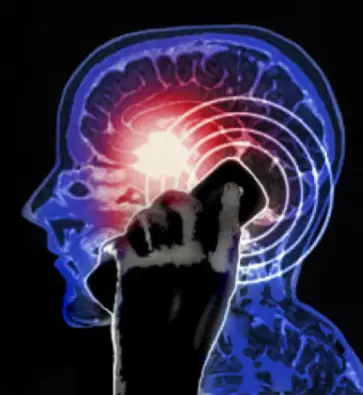
- Cell phones emit radiofrequency energy, a form of non-ionizing
electromagnetic radiation, which can be absorbed by tissues closest to
where the phone is held.
- The amount of radiofrequency energy a cell phone user is
exposed to depends on the technology of the phone, the distance between
the phone’s antenna and the user, the extent and type of use, and the
user’s distance from cell phone towers.
- Studies thus far have not shown a consistent link between cell
phone use and cancers of the brain, nerves, or other tissues of the head
or neck. More research is needed because cell phone technology and how
people use cell phones have been changing rapidly.
There are three main reasons why people are concerned that cell
phones (also known as “wireless” or “mobile” telephones) might have the
potential to cause certain types of cancer or other health problems:
- Cell
phones emit radiofrequency energy (radio waves), a form of non-ionizing
radiation. Tissues nearest to where the phone is held can absorb this
energy.
- The number of cell phone users has increased rapidly. Globally, the number of
cell phone subscriptions is estimated by the International
Telecommunications Union to be 5 billion.
- Over time, the number
of cell phone calls per day, the length of each call, and the amount of
time people use cell phones have increased. Cell phone technology has
also undergone substantial changes.
Radiofrequency energy is a form of electromagnetic radiation.
Electromagnetic radiation can be categorized into two types: ionizing
(e.g., x-rays, radon, and cosmic rays) and non-ionizing (e.g.,
radiofrequency and extremely low-frequency or power frequency).
Exposure to ionizing radiation, such as from radiation therapy,
is known to increase the risk of cancer. However, although many studies
have examined the potential health effects of non-ionizing radiation
from radar, microwave ovens, and other sources, there is currently no
consistent evidence that non-ionizing radiation increases cancer risk.
The
only known biological effect of radiofrequency energy is heating. The
ability of microwave ovens to heat food is one example of this effect of
radiofrequency energy. Radiofrequency exposure from cell phone use does
cause heating; however, it is not sufficient to measurably increase
body temperature.
A recent study showed that when people used a
cell phone for 50 minutes, brain tissues on the same side of the head as
the phone’s antenna metabolized more glucose than did tissues on the
opposite side of the brain.
The researchers noted that the results are preliminary, and possible
health outcomes from this increase in glucose metabolism are still
unknown.
Levels of radiofrequency exposure are indirectly estimated using
information from interviews or questionnaires. These measures include
the following:
- How “regularly” study participants use cell phones (the minimum number of calls per week or month)
- The
age and the year when study participants first used a cell phone and
the age and the year of last use (allows calculation of the duration of
use and time since the start of use)
- The average number of cell phone calls per day, week, or month (frequency)
- The average length of a typical cell phone call
- The total hours of lifetime use, calculated from the length of typical call times, the frequency of use, and the duration of use
Although there have been some concerns that radiofrequency energy
from cell phones held closely to the head may affect the brain and other
tissues, to date there is no evidence from studies of cells, animals,
or humans that radiofrequency energy can cause cancer.
It is
generally accepted that damage to DNA is necessary for cancer to
develop. However, radiofrequency energy, unlike ionizing radiation, does
not cause DNA damage in cells, and it has not been found to cause
cancer in animals or to enhance the cancer-causing effects of known
chemical carcinogens in animals (3–5).
Researchers
have carried out several types of epidemiologic studies to investigate
the possibility of a relationship between cell phone use and the risk of
malignant (cancerous) brain tumors, such as gliomas, as well as benign (noncancerous) tumors, such as acoustic neuromas (tumors in the cells of the nerve responsible for hearing), most meningiomas (tumors in the meninges, membranes that cover and protect the brain and spinal cord), and parotid gland tumors (tumors in the salivary glands).
In one type of study, called a case-control study,
cell phone use is compared between people with these types of tumors
and people without them. In another type of study, called a cohort study,
a large group of people is followed over time and the rate of these
tumors in people who did and didn’t use cell phones is compared. Cancer incidence
data can also be analyzed over time to see if the rates of cancer
changed in large populations during the time that cell phone use
increased dramatically. The results of these studies have generally not
provided clear evidence of a relationship between cell phone use and
cancer, but there have been some statistically significant findings in
certain subgroups of people.
What do expert organizations conclude?
The International Agency for Research on Cancer
(IARC), a component of the World Health Organization, has recently
classified radiofrequency fields as “possibly carcinogenic to humans,”
based on limited evidence from human studies, limited evidence from
studies of radiofrequency energy and cancer in rodents, and weak
mechanistic evidence (from studies of genotoxicity, effects on immune system function, gene and protein expression, cell signaling, oxidative stress, and apoptosis, along with studies of the possible effects of radiofrequency energy on the blood-brain barrier).
The American Cancer Society (ACS) states that the IARC classification means that there could be
some risk associated with cancer, but the evidence is not strong enough
to be considered causal and needs to be investigated further.
Individuals who are concerned about radiofrequency exposure can limit
their exposure, including using an ear piece and limiting cell phone
use, particularly among children.
The National Institute of Environmental Health Sciences
(NIEHS) states that the weight of the current scientific evidence has
not conclusively linked cell phone use with any adverse health problems,
but more research is needed.
The U.S. Food and Drug Administration
(FDA), which is responsible for regulating the safety of machines and
devices that emit radiation (including cell phones), notes that studies
reporting biological changes associated with radiofrequency energy have
failed to be replicated and that the majority of human epidemiologic
studies have failed to show a relationship between exposure to
radiofrequency energy from cell phones and health problems.
The U.S. Centers for Disease Control and Prevention
(CDC) states that, although some studies have raised concerns about the
possible risks of cell phone use, scientific research as a whole does
not support a statistically significant association between cell phone
use and health effects.
The Federal Communications Commission
(FCC) concludes that there is no scientific evidence that proves that
wireless phone use can lead to cancer or to other health problems,
including headaches, dizziness, or memory loss.




 (876) 893-4175
(876) 893-4175















